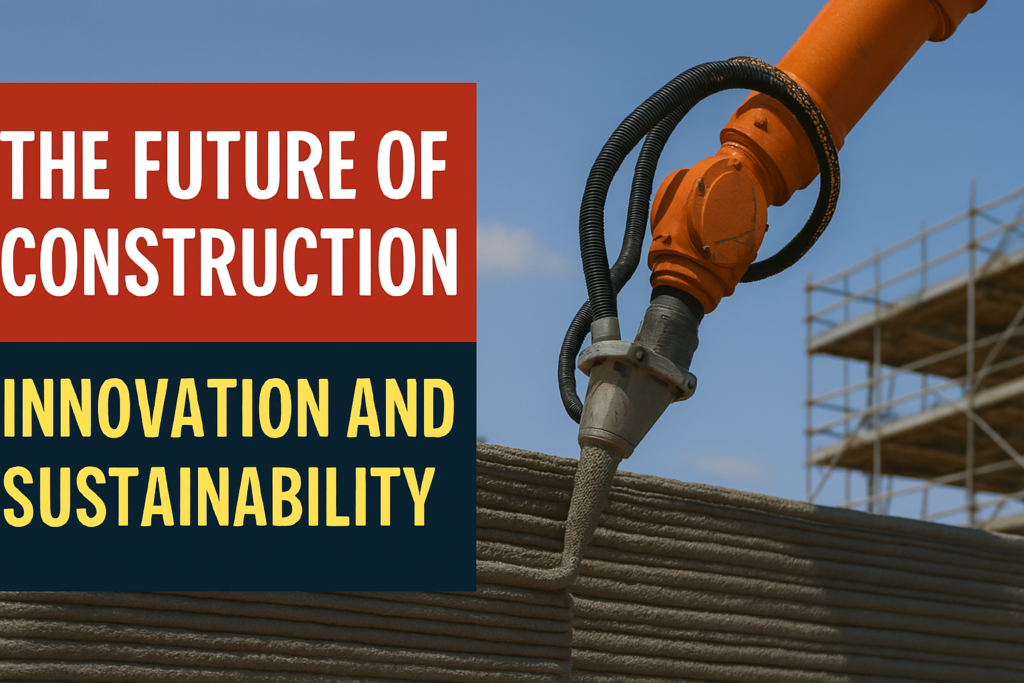
The construction industry has long been a cornerstone of economic growth and infrastructure development. From residential homes to towering skyscrapers, construction projects shape our environment and our future. As we move further into the 21st century, the industry is experiencing a massive transformation driven by technological advancements, sustainability, and a focus on efficiency. In this blog post, we’ll explore the emerging trends in construction and why embracing innovation is key to the future of the industry.
1. Sustainability Takes the Lead
Sustainability is no longer just a buzzword in the construction industry; it’s a necessity. With growing concerns about climate change and the environmental impact of traditional construction practices, companies are focusing on building eco-friendly structures that minimize energy consumption and reduce carbon footprints.
Some of the sustainable practices gaining popularity include:
- Green Building Materials: Using recycled materials and eco-friendly alternatives such as bamboo, hempcrete, and recycled steel to reduce waste.
- Energy-Efficient Designs: Implementing solar panels, energy-efficient windows, and proper insulation to ensure buildings consume less energy.
- Water Conservation: Installing rainwater harvesting systems and low-flow plumbing fixtures to reduce water consumption.
By adopting these practices, construction companies can build homes and commercial properties that are not only environmentally responsible but also reduce long-term operational costs for their owners.
2. The Rise of Smart Technology
The integration of smart technology into construction is revolutionizing the industry. From project planning to post-construction, technology is playing a crucial role in improving efficiency and reducing costs.
- Building Information Modeling (BIM): BIM allows for the digital representation of the physical and functional characteristics of a building. It improves collaboration among stakeholders, reduces errors, and enhances project management by allowing teams to visualize a project before construction begins.
- Drones and 3D Scanning: Drones are being used to monitor construction sites, providing real-time updates and aerial views. 3D scanning allows for precise measurements and models, improving accuracy in the construction process.
- Internet of Things (IoT): IoT-enabled devices are improving the monitoring of construction sites. Sensors can track equipment usage, materials inventory, and even environmental conditions, ensuring a smoother and safer building process.
These innovations are not only making construction more efficient but also more precise, helping companies complete projects faster and within budget.
3. Modular and Prefabricated Construction
In the past, the construction process was often lengthy and expensive. However, modular and prefabricated construction methods have emerged as cost-effective and time-saving solutions. In this approach, components of a building are manufactured in a factory and then assembled on-site, reducing construction time and costs.
Benefits of modular construction include:
- Speed: Since components are pre-built, the time spent on-site is significantly reduced.
- Cost Efficiency: Reduces the labor costs and risks associated with weather delays and other on-site issues.
- Quality Control: Components are built in a controlled factory environment, ensuring higher quality standards.
This trend is particularly beneficial for building affordable housing, schools, hospitals, and other infrastructure projects that require quick delivery.
4. 3D Printing in Construction
3D printing has become a game-changer in the construction industry. It offers the ability to print entire structures or specific components, such as walls, floors, and even furniture. This technology reduces material waste and allows for highly customized designs.
Some notable applications of 3D printing include:
- Affordable Housing: 3D-printed houses have been developed as a solution to the global housing crisis, offering low-cost and rapid construction.
- Architectural Customization: 3D printing enables the creation of unique architectural elements, such as intricate facades and sculptures, that would otherwise be difficult to produce using traditional methods.
While still in the early stages, 3D printing holds immense potential for the future of construction, especially in terms of affordability and customization.
5. Focus on Safety
Construction sites can be hazardous, with accidents causing injuries and delays. However, the industry is increasingly focusing on improving safety standards through technology and better practices. For example:
- Wearable Technology: Smart helmets and vests with built-in sensors can monitor workers’ vitals and send alerts if they’re at risk of heatstroke, fatigue, or other dangers.
- Safety Drones: Drones equipped with cameras can inspect hard-to-reach areas and identify potential hazards without putting workers at risk.
The goal is to make construction sites safer for workers and reduce accidents, which is vital for any business’s success.
6. The Labor Shortage Challenge
As the construction industry continues to evolve, there is a growing demand for skilled workers. However, the industry is facing a labor shortage, which could delay projects and increase costs. To address this challenge, companies are turning to:
- Training Programs: Developing comprehensive training programs to upskill workers and ensure they’re ready to handle new technology and advanced construction methods.
- Automation: The use of robots and AI to handle repetitive tasks, such as bricklaying and welding, can help fill gaps left by labor shortages.
By embracing automation and providing workers with the necessary skills, the construction industry can mitigate labor shortages while maintaining high productivity.
Conclusion
The future of construction is bright, with innovation and sustainability driving the industry toward new heights. Embracing advanced technologies, such as BIM, smart devices, and 3D printing, alongside sustainable building practices, will enable the creation of more efficient, cost-effective, and environmentally-friendly structures. As the industry continues to evolve, those who adapt to these changes will remain at the forefront, shaping the built environment for generations to come.
The key to thriving in the construction industry in the future will be a combination of creativity, adaptability, and a commitment to delivering high-quality projects that meet the needs of both the environment and society. With the right tools and mindset, the sky’s the limit for the construction sector.
